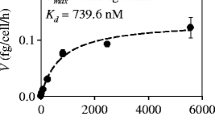Abstract
The combined effect of cadmium (CdCl2) and high temperature on the subsequent growth, the synthesis of nucleic acids and protein, and the cell cycle in HeLa S3 cells was investigated. The subsequent growth rate was depressed by cadmium at 37.1°C. This suppression effect was enhanced at 40.4° C compared with the effect at 37.1° C. The synthesis of DNA, RNA and protein was inhibited at higher temperatures in cultivation without cadmium, and depressed at each temperature in a concentration-dependent manner by the addition of cadmium. The DNA, RNA and protein-IC50 values at 40.4° C decreased compared with the values at 37.1° C. The DNA and RNA-IC50 values were significantly decreased (p<0.01,p<0.005, respectively) depending on the temperature. After treating the cells with cadmium at 40.4° C, the DNA/BrdUrd distribution showed that the rate of dead cells increased and the rate of the G1/G0 phase decreased. These results indicate that the inhibitory effect of cadmium on the subsequent growth of HeLa S3 cells is enhanced at high temperature and this enhancement is related to the increased inhibitory effect of cadmium on DNA and RNA synthesis at high temperature.
Similar content being viewed by others
References
Bhuyan BK, Day KJ, Edgerton CE, Ogunbase O (1977) Sensitivity of different cell lines and of different phases in the cell cycle to hyperthermia. Cancer Res 37: 3780–3784
Cavaliere R, Ciocatto EC, Giovannella BC, Heidelberger C, Johnson RO, Morgottini M, Mondovi B, Morrica G, Rossi-Fanelli A (1967) Selective heat sensitivity of cancer cells. Cancer 20: 1351–1381
Courgeon A, Maisonhaute C, Best-Belpomme M (1984) Heat shock proteins are induced by cadmium in Drosophila cells. Exp Cell Res 153: 515–521
Dolbeare F, Gratzner H, Pallavicini MG, Gray JW (1983) Flow cytometric measurement of total DNA content and incorporated bromodeoxyuridine. Proc Natl Acad Sci USA 80: 5573–5577
Evans RM, Patierno SR, Wang D, Cantoni O, Costa M (1983) Growth inhibition and methallothionein induction in cadmium-resistant cells by essential and non-essential metals. Mol Pharmacol 24: 77–83
Gierthy JF, Frenkel GD (1984) A comparative study of the effects of mercury compounds on cell viability and nucleic acid synthesis in HeLa cells. Biochem Pharmacol 33: 1941–1945
Henle KJ, Dethlefsen LA (1980) Time-temperature relationships for heat-induced killing of mammalian cells. Ann NY Acad Sci 35: 234–253
Jacobson KB, Turner JE (1980) The interaction of cadmium and certain other metal ions with proteins and nucleic acids. Toxicology 16: 1–37
Kim SH, Kim JH, Hahn EW (1976) The enhanced killing of irradiated HeLa cells in synchronous culture by hyperthermia. Radiat Res 66: 337–345
Kishimoto T, Okazaki M, Fukuzawa Y, Tada M (1985) The effects of cadmium on the adhesion and growth of normal and malignant human cells at high temperature. Shimane J Med Sci 9: 60–68
Kishimoto T, Okazaki M, Fukuzawa Y, Tada M (1987) The effects of antifebrile agent sulpyrine on the synthesis of DNA, RNA and protein in HeLa S3 cells at high temperature. Jpn J Biometeor 24(2): 59–65
Koizumi S, Sone T, Otaki N, Kimura M (1985) Cd2+-induced synthesis of methallothionein in HeLa cells. Biochem J 227: 879–886
Lauwerys R (1979) Cadmium in man. In: Webb M (ed) The chemistry, biochemistry and biology of cadmium. Elsevier North Holland Biomedical Press, Amsterdam, pp 433–442
Mondovi B, Finazzi AA, Rotilio G, Strom R, Morrica G, Rossi-Fanelli A (1969) The biochemical mechanism of selective heat sensitivity of cancer cells. Eur J Cancer 5: 137–146
Morselt AFW, Peereboom-Stegman C, Jongstra-Spaapen EJ, James J (1983a) Investigation for the mechanism of cadmium toxicity at cellular level I. A light microscopical study. Arch Toxicol 52: 91–97
Morselt AFW, Peereboom-Stegman C, Puvion E, Maarschalkerweerd VJ (1983b) Investigation for the mechanism of cadmium toxicity at cellular level II. An electron microscopical study. Arch Toxicol 52: 99–108
Nahid F, Kurt GH (1983) Evidence for separate modes of action in thermal radiosensitization and direct thermal cell death. Cancer 51: 38–43
Puck TT, Marcus PI, Cieciura SJ (1956) Clonal growth of mammalian cells in vitro; growth characteristics of colonies from single HeLa cells with and without a feeder layer. J Exp Med 103: 273–283
Samarawickrama GP (1979) Biological effects of cadmium in mammals. In: Webb M (ed) The chemistry, biochemistry and biology of cadmium. Elsevier North Holland Biomedical Press, Amsterdam, pp 341–356
Scherer FW, Syverton JT, Gey GO (1953) Studies of the propagation in vitro of poliomyelitis viruses. IV. Viral multiplication in a stable strain of human malignant epithelial cells (strain HeLa) derived from an epidermoid carcinoma of the cervix. J Exp Med 97: 695–715
Subjeck JR, Thung-Tai S (1986) Stress protein systems of mammalian cells. Am J Physiol 250 [Cell Physiol 19]: C1-C17
Author information
Authors and Affiliations
Rights and permissions
About this article
Cite this article
Kishimoto, T., Fukuzawa, Y. & Tada, M. Combined effect of cadmium (CdCl2) and high temperature on HeLa S3 cells. Arch Toxicol 64, 383–386 (1990). https://doi.org/10.1007/BF01973460
Received:
Revised:
Accepted:
Issue Date:
DOI: https://doi.org/10.1007/BF01973460




